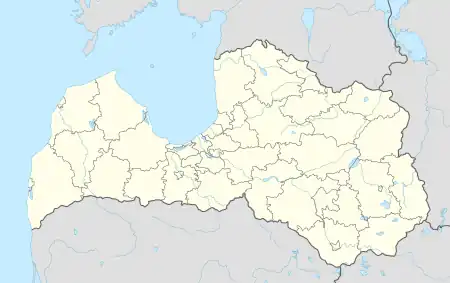Carnikava
Sānkaule | |
|---|---|
Large village | |
.jpg.webp) Carnikava Railway Station in 2018 | |
 Carnikava Carnikava's location in Latvia | |
| Coordinates: 57°8′0″N 24°17′0″E / 57.13333°N 24.28333°E | |
| Country | |
| Municipality | Ādaži |
| Parish | Carnikava |
| Area | |
| • Land | 493 km2 (190 sq mi) |
| Elevation | 6 m (20 ft) |
| Population (2020) | |
| • Total | 4,689 |
| Time zone | UTC+2 (EST) |
| • Summer (DST) | UTC+3 (EEST) |
| Post code | LV-2163 |
Carnikava (Livonian: Sarnikau, German: Koivemund, Zarnikau), previously Sānkaule, is a village and the center of Carnikava Parish in Ādaži Municipality, Latvia. It's located 25 km north from Riga at the mouth of the Gauja River. Carnikava had 4689 residents as of January 2020, making it the largest village by population in Latvia (List of largest villages in Latvia).[1]
Etymology
The name Carnikava is believed to be of Livonian origin, with Sarnikau translating as 'ash tree valley' (ošleja in Latvian). In German, the name Koivemund translates as 'the mouth of the Koiva (river)', with Koiva being a Finno-Ugric name of the Gauja River. Sānkaule was briefly borrowed from one of the names of Carnikava Manor at the time.[2]
History
The village was first mentioned in Livonian Chronicle of Henry in 1211 as a summoning place of Livonian troops. Later Carnikava grew into a fishermen village, where in the 17th century the first breeding fishery and canned fish factory in the Russian Empire was built. Due to its proximity to the Baltic Sea, several forest lakes, the Gauja and annual fishermen and craftsmanship fairs, nowadays Carnikava is a popular summer resort among visitors from Riga.
Heinz Christian Pander (1794-1865), researcher of biology, embryology and paleontology, lived and worked in Carnikava in his estate. The Carnikava Manor (Latvian: Carnikavas muiža), built in the 17th century, was destroyed by Russian soldiers in a fire in the autumn of 1917 around the time of the Riga offensive, with the ruins ultimately demolished by the Soviet occupational authorities in the 1960s to make way for a Soviet military cemetery. Today, a column chapiter in the middle of a park in the center of Carnikava marks the heritage of the manor.[3][4]
Until 1992, most of the Carnikava Parish was a part of Ādaži Parish, with its western part included in Mangaļi Parish until after World War II, when it was abolished and split between Riga's Mangaļi neighbourhood and Ādaži Parish. In 1992, Carnikava Parish split from Ādaži Parish, with both being parts of the Riga District until 2009, when a separate Carnikava Municipality was created. Ultimately, it was merged into the Ādaži Municipality as Carnikava Parish in 2021.
Culture
A notable symbol and long-time culinary specialty of Carnikava has been grilled lamprey, which is also pictured on the coat of arms of the parish. Carnikava lamprey has been awarded the Protected geographical indication seal of the European Union and is included into the Latvian Intangible Cultural Heritage list.[5][6][7]
References
- ↑ "Vietvārdu datubāze" [Placename Database]. vietvardi.lgia.gov.lv (in Latvian). Archived from the original on 2021-01-26. Retrieved 2020-05-22.
- ↑ "Carnikavas pagasts". Latvian National Encyclopedia (in Latvian). Retrieved 2023-12-17.
- ↑ "Ādažu novada vēsture | Ādaži" [History of Ādaži Municipality]. www.adazunovads.lv (in Latvian). Retrieved 2023-12-17.
- ↑ "Carnikava manor park". tourism.ādaži.lv. 2021-10-27. Retrieved 2023-12-17.
- ↑ "Carnikava district". tourism.carnikava.lv. Retrieved 2020-05-22.
- ↑ "Nēģu ķeršanas un apstrādes prasmes Carnikavā (2019) – Nematerialakultura.lv". Retrieved 2023-12-17.
- ↑ "Carnikava lampreys win EU Protected Designation". eng.lsm.lv. 2015-02-20. Retrieved 2023-12-17.
External links